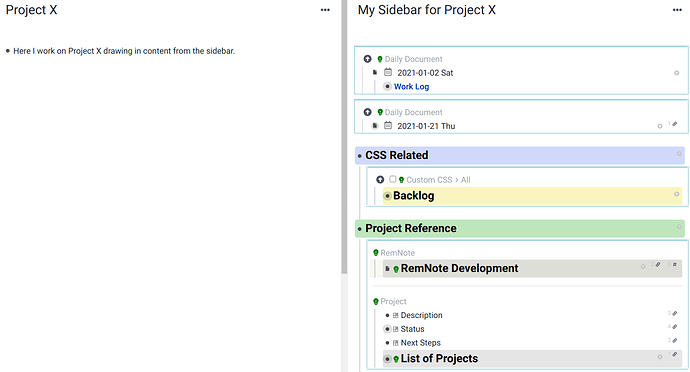This is a wiki post. Feel free to improve it!
RemNote’s portals are pretty flexible and powerful. You can for example build a sidebar in the right pane showing the content of multiple documents with them. Since this “sidebar” is just a plain Rem with a bunch of portals in it, this means:
- It is persistent. The sidebar is saved if you close it.
- You can have multiple sidebars, e.g. one for each of your projects.
- You can add arbitrary content, not just portals, structure with indentation etc.
And since the hiding state of a portal is separate from the origial document you can change that freely without worrying about the portaled document.
Sidebar Workflow
Adding Portals to the Sidebar
From search
Click in the sidebar and press Ctrl + S (or click into the search box in the bottom toolbar) and search for the Rem you want to add.
If you are inside a search portal already the result gets appended as a section to the current portal. If you are outside any portals a new portal is created.
From a reference
You can Ctrl + Click a reference to create a portal to it. This action is also accessible from the Rem’s context menu.
If you do this in the left pane you can move the portal to the right like shown below.
Moving Portals
You can move a portal
- by dragging the three dots next to the portals top border,
- by focusing the top border (it highlights orange) and Ctrl + X, Ctrl + V or
- by focusing the top border and Alt + ↑ / ↓.
Change Rem shown in a Portal
This is done by hiding. Type /hide to view the hiding options:
-
Hide From Document(Ctrl + Alt + H): Hide the focused Rem. -
Hide Parent & Siblings From Document(Ctrl + Shift + H): Hide everything but the focused Rem. This is useful to focus on a specific part of a complex hierarchy.
To reveal an individual child again press Ctrl + Shift + C on the parent (or hover its bullet point) and search for the child to add.
You can also show / hide all children (ancestors) of a Rem with Ctrl + (Shift +) ↓ / ↑.
Removing Portals
- To remove a whole portal click the top border such that it turns orange and press Del. This only removes the portal, not the portaled rem.
- To remove a part of a portal (e.g. of a multipart portal) just hide the rem with Ctrl + Shift + H.
Note: If you delete something inside a portal it is also deleted from its original place.
Tips & Tricks
- Use headings and indent one or more portals to quickly fold them away.
- Use Custom CSS to have a different zoom factor for the sidebar:
CSS Code
:root {
--zoom-factor-right-pane: 0.7;
}
#multiple-windows .pane:last-child #hierarchy-editor-list__inner {
width: calc(100% / var(--zoom-factor-right-pane));
height: calc(100% / var(--zoom-factor-right-pane));
transform: scale(var(--zoom-factor-right-pane));
transform-origin: top left;
}
Dev Wishlist
There are a few things that would make this workflow easier:
- Shortcut to focus the other pane saving the last edit location.
- Shortcut to move a rem to the other pane at the last edit location.
- Shortcut to add a portal for the highlighted reference as listed in Reference Context Menu UX.
- Maybe add a command to directly create the portal in the other pane.

